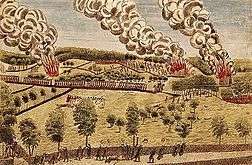Timeline of the American Revolution
Timeline of the American Revolution — timeline of the political upheaval in the 18th century in which Thirteen Colonies in North America joined together for independence from the British Empire, and after victory in the Revolutionary War combined to form the United States of America. The American Revolution includes political, social, and military aspects. The revolutionary era is generally considered to have begun with the passage of the Stamp Act in 1765 and ended with the ratification of the United States Bill of Rights in 1791. The military phase of the revolution, the American Revolutionary War, lasted from 1775 to 1783.
1760s
1760
- Pierre de Rigaud, Governor of New France, capitulates (September 8) to Field Marshal Jeffrey Amherst. This ends most fighting in North America between France and Great Britain in the French and Indian War. Amherst becomes the First British Governor-General of territories that would later become Canada plus lands (Ohio Country and Illinois Country) west of the American Colonies.
- King George II of Great Britain dies (October 25) and is succeeded by his grandson George III.
1761
- New England Planters immigrate to Nova Scotia, Canada (1759-1768) to take up lands left vacant after the Expulsion of the Acadians.
1763
- The Treaty of Paris (February 10) formally ends the French and Indian War. France cedes most of its territories in North America to Great Britain, but Louisiana west of the Mississippi River is ceded to Spain.
- Previously allied with France, Native American tribes in the Great Lakes region resist the policies of the British under Amherst. Pontiac's Rebellion begins, lasting until 1766.
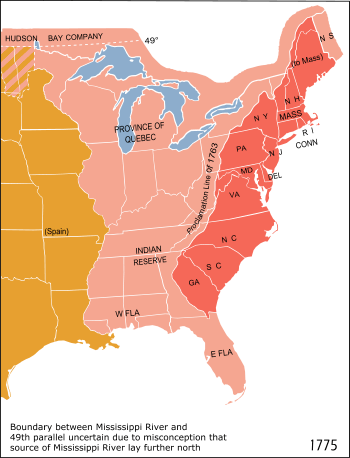
The extent of America's territorial growth prior to the Revolution. The westward border established by the Royal Proclamation of 1763 is shown.
- King George's Royal Proclamation of 1763 (October 7) establishes administration in territories newly ceded by France. To prevent further violence between settlers and Native Americans, the Proclamation sets a western boundary on the American colonies.
- The Navigation Acts are re-enforced by George Grenville as a part of his attempt to reassert unified economic control over the British Empire following the Seven Years' War.
1764
- The Sugar Act (April 5), intended to raise revenues, and the Currency Act (September 1), prohibiting the colonies from issuing paper money, are passed by Parliament. These Acts, coming during the economic slump that followed the French and Indian War, are resented by the colonists and lead to protests.
1765
- To help defray the cost of keeping troops in America, Parliament enacts (March 22) the Stamp Act, imposing a tax on many types of printed materials used in the colonies. Seen as a violation of rights, the Act sparks violent demonstrations in several Colonies. Virginia's House of Burgesses adopts (May 29) the Virginia Resolves claiming that, under British law, Virginians could be taxed only by an assembly to which they had elected representatives.
- Delegates from nine colonies attend the Stamp Act Congress which adopts (October 19) a Declaration of Rights and Grievances and petitions Parliament and the king to repeal the Act.
- Parliament enacts (March 24) the Quartering Act, requiring the Colonies to provide housing, food, and other provisions to British troops. The act is resisted or circumvented in most of the colonies. In 1767 and again in 1769, Parliament suspended the governor and legislature of New York for failure to comply.
1766
- The British Parliament repeals (March 18) the unpopular Stamp Act of the previous year, but, in the simultaneous Declaratory Act, asserts its "full power and authority to make laws and statutes ... to bind the colonies and people of America ... in all cases whatsoever".
- Liberty Pole erected in New York City commons in celebration of the Stamp Act repeal (May 21). An intermittent skirmish with the British garrison over the removal of this and other poles, and their replacement by the Sons of Liberty, rages until the Province of New York is under the control of the revolutionary New York Provincial Congress in 1775
1767
- The Townshend Acts, named for Chancellor of the Exchequer Charles Townshend, are passed by Parliament (June 29), placing duties on many items imported into America.
1768
- In April, Britain's Secretary of State for the Colonies, Lord Hillsborough, orders colonial governors to stop their own assemblies from endorsing Adams' circular letter. Hillsborough also orders the governor of Massachusetts to dissolve the general court if the Massachusetts assembly does not revoke the letter. By month's end, the assemblies of New Hampshire, Connecticut and New Jersey have endorsed the letter.
- In May, a British warship armed with 50 cannon sails into Boston harbor after a call for help from custom commissioners who are constantly being harassed by Boston agitators. In June, a customs official is locked up in the cabin of Liberty, a sloop owned by John Hancock. Imported wine is then unloaded illegally into Boston without payment of duties. Following this incident, customs officials seize Hancock's sloop. After threats of violence from Bostonians, the customs officials escape to an island off Boston, then request the intervention of British troops.
- In July, the governor of Massachusetts dissolves the general court after the legislature defies his order to revoke Adams' circular letter. In August, in Boston and New York, merchants agree to boycott most British goods until the Townshend Acts are repealed. In September, at a town meeting in Boston, residents are urged to arm themselves. Later in September, English warships sail into Boston Harbor, then two regiments of English infantry land in Boston and set up permanent residence to keep order.
1769
- To the Betrayed Inhabitants of the City and Colony of New York broadside published by the local Sons of Liberty (c. December)
1770s
1770
- Golden Hill incident in which British troops wound civilians, including one death (January 19)
- Lord North becomes Prime Minister of Great Britain (January 28)
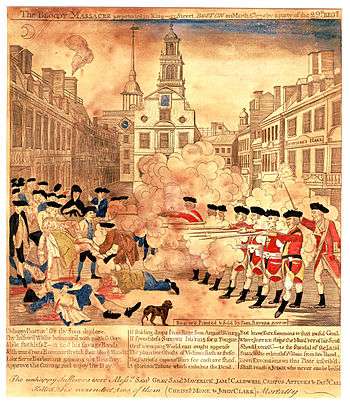
The Boston Massacre, an engraving by patriot Paul Revere.
- Boston Massacre (March 5)
1771
- Battle of Alamance in North Carolina (May 16)
1772
- Samuel Adams organizes the Committees of Correspondence
- GaspeeAffair (June 9)
- The Watauga Association in what would become Tennessee declares itself independent.
1773
- Parliament passes the Tea Act (May 10)
- Association of the Sons of Liberty in New York published by local Sons of Liberty (December 15)
- Boston Tea Party (December 16)
1774
- Benjamin Franklin, Massachusetts' agent in London, is questioned before Parliament
- Lord Dunmore's War
- British pass Intolerable Acts, including:
- Boston Port Act (March 31)
- Administration of Justice Act (May 20),
- Massachusetts Government Act (May 20),
- A second Quartering Act (June 2), and
- Quebec Act
- The Powder Alarm, General Gage's secret raid on the Cambridge powder magazine (September 1)
- The First Continental Congress meets; twelve colonies send delegates
- The burning of Peggy Stewart (October 19)
- Petition to the King (October 26)
- Greenwich Tea Party (December 22)
1775
- Battles of Lexington and Concord, followed by the Siege of Boston (April 19)
- Gunpowder Incident (April 20)
- Skenesboro, New York (now Whitehall, New York) captured by Lieutenant Samuel Herrick. (May 9)
- Fort Ticonderoga captured by Ethan Allen, Benedict Arnold and the Green Mountain Boys. (May 10)
- Second Continental Congress meets (May 10)
- Congress votes to create Continental Army out of the militia units around Boston and appointed George Washington of Virginia as commanding general. This would later become the modern United States Army(June 14)
- Battle of Bunker Hill (June 17)
- Washington arrives in Cambridge, Massachusetts to take command of the Continental Army (July 2)
- Declaration of the Causes and Necessity of Taking Up Arms issued (July 6)
- Olive Branch Petition sent to King George III (July 8)
- Continental Marines established by Continental Congress. They would become the modern day United States Marine Corps (November 10)
- Henry Knox transported fifty-nine captured cannon (taken from Fort Ticonderoga and Fort Crown Point) from upstate New York to Boston, Massachusetts. Trip took 56 days to complete. (December 5, 1775 to January 24, 1776)
1776
- New Hampshire ratifies the first state constitution
- Thomas Paine publishes Common Sense (January 10)
- Battle of Moore's Creek Bridge (February 27)
- Battle of Nassau (March 3–4)
- Fortification of Dorchester Heights results in British forces evacuating Boston (March 4–5)
- British evacuate Boston (March 17)
- The Newly formed Continental Army departs its first winter encampment at Cambridge, Massachusetts (April)
- Battle of Turtle Gut Inlet (June 29)
- Second Continental Congress enacts (July 2) a resolution declaring independence from the British Empire, and then approves (July 4) the written Declaration of Independence.
- Sons of Liberty order African slaves to topple statue of King George III in Bowling Green (New York City) (July 9)
- Battle of Long Island, a.k.a. Battle of Brooklyn (August 27)
- British prison ships begin in Wallabout Bay, New York
- Staten Island Peace Conference (September 11)
- Landing at Kip's Bay (September 15)
- Battle of Harlem Heights (September 16)
- Great Fire of New York (September 21–22)
- Nathan Hale captured and executed for espionage (September 22)
- Battle of Valcour Island (October 11)
- Battle of White Plains (October 29)
- Battle of Fort Washington (November 16)
- Battle of Fort Lee (November 20)
- Battle of Iron Works Hill (December 23 – December 26)
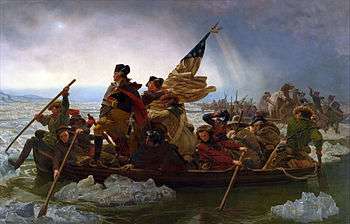
Washington Crossing the Delaware, painting 1851 by Emanuel Leutze
- Battle of Trenton (December 26)
1777
- Battle of the Assunpink Creek, also known as the Second Battle of Trenton, (January 2)
- Battle of Princeton (January 3)
- Continental Army enters second winter encampment of the war at Morristown (January 6)
- Forage War (January – March):
- Battle of Millstone (January 20)
- Battle of Drake's Farm (February 1)
- Battle of Quibbletown (February 8)
- Battle of Spanktown (February 23)
- Battle of Bound Brook (April 13)
- Sybil Ludington, 16-year-old daughter of American Colonel Henry Ludington, makes a 40-mile (64 km) ride in the early hours of the night (April 26)
- British regulars, under Major General William Tryon, burn and loot Danbury, Connecticut (April 26)
- Battle of Ridgefield (April 27)
- Middlebrook encampment (May 28 – July 2)
- Battle of Short Hills (June 26)
- Fort Ticonderoga abandoned by the Americans due to advancing British troops placing cannon on Mount Defiance. (July 5)
- British retake Fort Ticonderoga. (July 6)
- Battle of Hubbardton (July 7)
- Delegates in Vermont, which was not one of the Thirteen Colonies, establish a republic and adopt (July 8) a constitution—the first in what is now the territory of the United States to prohibit slavery. (Vermont would become the fourteenth state in 1791.)
- Battle of Oriskany (August 6)
- Battle of Bennington (August 16)
- Battle of Brandywine (September 11)
- Battle of Paoli (Paoli Massacre) (September 20)
- British occupation of Philadelphia (September 26)
- Battle of Germantown (October 4)

Surrender of General Burgoyne, 1821 painting by John Trumbull
- Two Battles of Saratoga (September 19 and October 7) conclude with the surrender of the British army under General Burgoyne.
- Battle of Red Bank (October 22)
- Articles of Confederation adopted by the Second Continental Congress (November 15)
- Capture of Fort Mifflin, (November 16) and Fort Mercer, (November 18)
- Battle of White Marsh (December 5 – December 8)
- Battle of Matson's Ford (December 11)
- 1777–1778 – Continental Army in third winter quarters at Valley Forge (December 19 – June 19)
1778
- Treaty of Amity and Commerce and Treaty of Alliance with France (February 6)
- Battle of Barren Hill (May 20)
- British occupation of Philadelphia ends (June)
- Battle of Monmouth (June 28)
- Capture of Savannah (December 28) British successfully launch their southern strategy
- 1778–1779 – Majority of Continental Army in fourth winter quarters at Middlebrook encampment (November 30 – June 3)
- 1778-1779 - Major General Israel Putnam choses Redding, Connecticut as his winter encampment to keep an eye on the storehouses in Danbury, Connecticut.
1779
- Siege of Fort Vincennes (February 23–25)
- Tryon's raid (July 3 - July 14)
- Tryon's division lands in East Haven, Connecticut,met with spirited resistance from a band of local militia, take Black Rock Fort (July 5)
- Battle of Fairfield Destroy 54 barns, 47 storehouses, burned 83 homes, two churches, and municipal buildings including a schoolhouse, the courthouse and the local jail (July 7)
- Battle of Norwalk weakly opposed by about 50 local militia, easily dispersed. The destruction of the village and its commercial infrastructure destroyed (July 11)
- Battle of Stony Point (July 16)
- Battle of Paulus Hook (August 19)
- 1779–1780 Continental Army in fifth winter quarters at Morristown (December–May)
1780s
1780
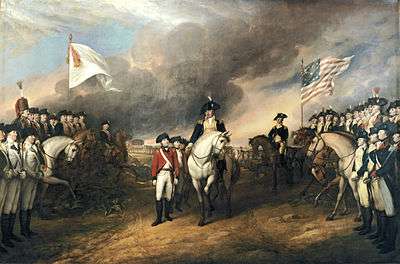
Surrender of Lord Cornwallis at Yorktown, 1820 painting by John Trumbull
- January 15 – Congress establishes the Court of Appeals in Cases of Capture to provide for final adjudication of appeals from state court prize cases involving disposition of ships and cargo allegedly seized from the British.
- January 28 – A stockade known as Fort Nashborough is founded on the banks of the Cumberland River.Two years later the site is renamed Nashville.
- February 1 – Some 8,000 British forces under General Henry Clinton arrive in Charleston, South Carolina, from New York.
- February 1 – New York cedes to Congress its western claims, including territory west of Lake Ontario. In 1792 New York will sell the Erie Triangle to Pennsylvania
- March 14 – Bombardment of Fort Charlotte: After a two-week siege, Spanish general, colonial governor of Louisiana, and Viceroy of New Spain Bernardo de Gálvez captures Fort Charlotte, taking the port of Mobile (in present-day Alabama) from the British. Fort Charlotte was the last remaining British frontier post capable of threatening New Orleans in Spanish Louisiana. Its fall drove the British from the western reaches of West Florida and reduced the British military presence in West Florida to its capital, Pensacola.
- April 8 – Siege of Charleston: British Army troops under General Henry Clinton and naval forces under Admiral Mariot Arbuthnot besiege Charleston, South Carolina. British ships sail past Fort Moultrie on Sullivan's Island to occupy Charleston Harbor. Washington will order reinforcements to Charleston, but the city falls on May 12 in what is arguably the worst American defeat of the war.
- May 6 – Siege of Charleston: Fort Moultrie falls to the British.
- May 12 – Siege of Charleston: American General Benjamin Lincoln surrenders Charleston to the British. The British lose 255 men while capturing a large American garrison.
- May 29 – Battle of Waxhaws: A clash between Continental Army forces under Abraham Buford and a mainly Loyalist force led by Banastre Tarleton occurs near Lancaster, South Carolina in the Waxhaws area (close to present-day Buford). The British destroyed the American forces.
- June 6 – Battle of Connecticut Farms
- June 23 – Battle of Springfield. With the attempted British invasion of New Jersey stopped at Connecticut Farms and Springfield, major fighting in the North ends.
- June 27 - Robert Morris is appointed Superintendent of Finance, a post akin to Prime Minister, by Congress.
- August 16 - Battle of Camden. British General Cornwallis gains a humiliating victory over Gates in South Carolina.
- September 23 – John André captured and the treason of Benedict Arnold is exposed
- September 26 - Battle of Charlotte
- October 7 – Battle of King's Mountain
- December - Continental Army enters sixth winter with encampments in New York’s Hudson Highlands and Pompton and Morristown New Jersey
1781
- January 17 - Battle of Cowpens
- March 1 – Articles of Confederation ratified
- March 15 – Battle of Guilford Court House
- September 5 - Battle of the Chesapeake
- September 6 - Battle of Groton Heights
- September 8 - Battle of Eutaw Springs
- October 19 – The British surrender at Yorktown
- December 31 – Bank of North America chartered
- December - Continental Army returns to Hudson Highlands and Morristown New Jersey for its seventh winter encampment.
1782
- February 27 – The British House of Commons votes against further war, informally recognizing American independence.
- August 27 - Battle of the Combahee River
- September 11-13, - Siege of Fort Henry (1782)
- November - Continental Army moves into its eighth and final winter quarters, at the New Windsor Cantonment and in the Hudson Highlands
- November 30 - preliminary Articles of Peace are signed by British negotiator Richard Oswald and representatives of the United States of America.
- December 14 – British evacuate Charleston, South Carolina
- 1783
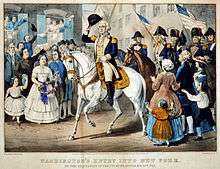
Washington's Entry into New York by Currier & Ives
- September 3 – The Treaty of Paris (1783) ends the American Revolutionary War
- November 25 – The British evacuate New York, marking the end of British rule, and General George Washington triumphantly returns with the Continental Army.
1784
- January 14 – The Treaty of Paris is ratified by the Congress.
- April 9 – The Treaty of Paris is ratified by the British
- May 12 – Ratified treaties are exchanged in Paris between the two nations.
- August – "The state of Frankland," later known as Franklin, secedes from North Carolina
- November 1 - Robert Morris resigns as Superintendent of Finance and is not replaced.
1785
- Treaty of Hopewell (November 28)
- Congress refuses admission of Franklin to the Union
- 1786
1787
- Constitutional Convention in Philadelphia
- Delaware, Pennsylvania and New Jersey ratify the Constitution
1788
- North Carolina reasserted it claim to its Overmountain region, at which time Franklin ceases to exist.
- Georgia, Connecticut, Massachusetts, Maryland, South Carolina, New Hampshire, Virginia and New York ratify the Constitution
- United States Constitution goes into effect
- November 2 -Cyrus Griffin resigns as "President of the United States in Congress Assembled", and with the exceptions of John Jay and John Knox remaining as Secretaries of Foreign Affairs and War respectively; and Michael Hillegas remaining as Treasurer, the United States of America temporarily ceases to exist.
- The first federal Elections for the House of Representatives begin.
1789
- United States presidential election, 1788-89, George Washington is elected president; John Adams elected vice president
- March 4: The First Congress attempts to convene for the first time.
- Congress formally convenes.
- results of Presidential election certified.
- John Adams becomes Vice President
Presidency of George Washington
- George Washington becomes the first President;
- Charles Thomson resigns as secretary of Congress in July 1789 and hands over the Great Seal, bringing an end to the Confederation Congress.
- The First United States Congress passes the Judiciary Act of 1789 and Hamilton tariff
- November 21 – North Carolina becomes the 12th state to ratify the Constitution, with a vote of 194–77
See also
References
Further reading
- Fremont-Barnes, Gregory, and Richard Alan Ryerson, eds. The Encyclopedia of the American Revolutionary War: A Political, Social, and Military History (5 vol. 2006)
- Morris, Richard B. Encyclopedia of American History (7th ed. 1996)
External links
| Wikimedia Commons has media related to American Revolution. |
This article is issued from
Wikipedia.
The text is licensed under Creative Commons - Attribution - Sharealike.
Additional terms may apply for the media files.
